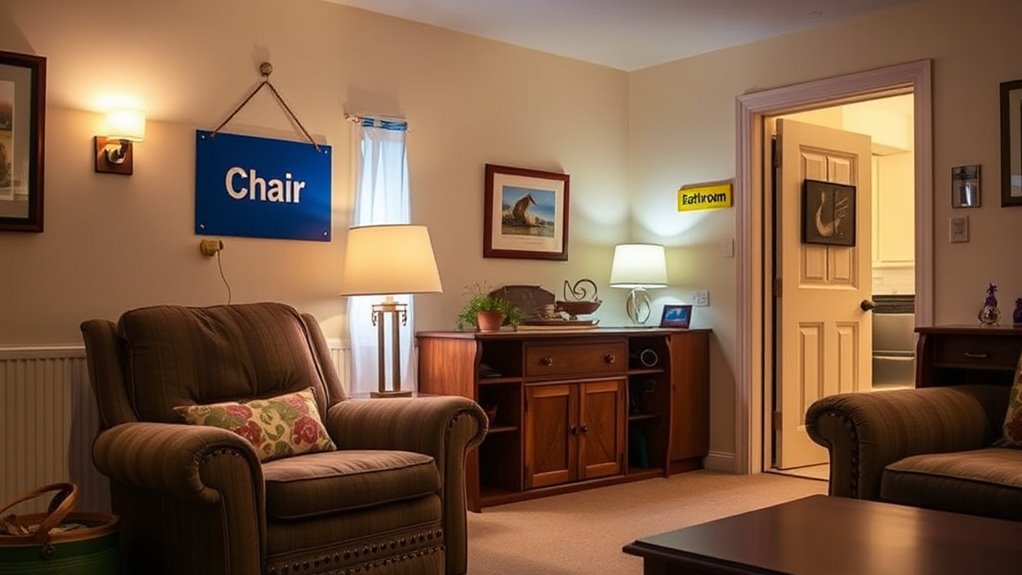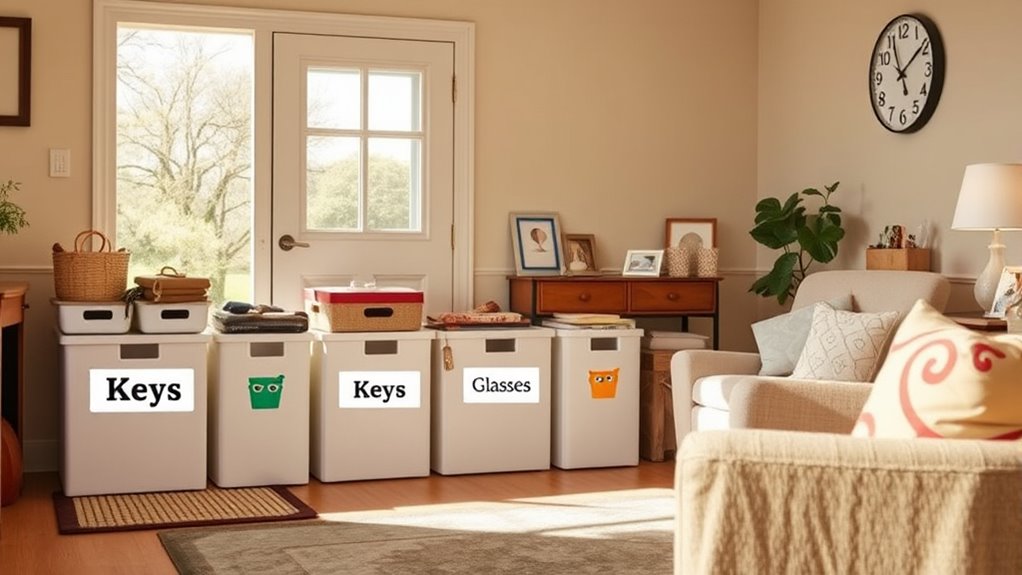To create a dementia-friendly home, use clear labels on doors and cabinets, along with simple visual cues like arrows or color coding to guide movement. Incorporate familiar photographs or tactile elements to stimulate senses and reinforce routines. Personalize cues to suit individual preferences, helping them feel more in control and safe. Thoughtful signage and sensory prompts enhance independence while reducing confusion. For more ideas on designing a supportive environment, keep exploring ways to make your home accessible and comforting.
Key Takeaways
- Use clear, simple labels on doors and cabinets to enhance identification and independence.
- Incorporate visual cues like arrows, color coding, or photographs to guide navigation and orientation.
- Personalize cues based on individual preferences to foster familiarity and emotional comfort.
- Implement sensory stimuli such as textures or sounds to reinforce routines and improve engagement.
- Ensure safety by avoiding clutter, using clear signage, and placing cues thoughtfully to prevent confusion.

Creating a dementia-friendly home environment is essential for supporting independence and safety. One effective way to achieve this is through the use of labels and cues that help your loved one navigate daily life with confidence. Personalized safety measures are key, as they address the unique needs and routines of the individual. For example, clear labels on cabinets, doors, and appliances can reduce confusion and prevent accidents. When you label the bathroom door as “Bathroom” or the fridge as “Food,” it becomes easier for your loved one to find what they need without frustration or risk. You can also add visual cues, such as arrows or color codes, to guide them along familiar pathways within the home. This personalized approach helps create a sense of familiarity and control, which is essential for maintaining independence.
In addition to labels, sensory stimulation plays a key role in supporting individuals with dementia. Incorporating visual, tactile, and auditory cues can reinforce memory and orientation. For example, placing a familiar photograph or a favorite piece of artwork near the entrance can serve as a visual cue, helping your loved one recognize their space. Tactile cues, like textured mats or soft fabrics, can provide comforting sensory input and help distinguish different areas of the home. Sound cues, such as a chime or a specific melody, can signal transitions or remind them of routines, like mealtime or bedtime. These sensory stimulations aren’t just about aiding navigation—they also promote engagement and emotional well-being.
Creating clear, simple cues tailored to the individual’s preferences and history encourages autonomy. Use consistent signage and cues throughout the home, ensuring they’re easy to see and understand. Keep in mind that overloading the environment can cause confusion, so focus on a few well-placed labels and sensory cues rather than cluttering spaces. It’s also helpful to involve your loved one in the process, asking what cues they find most helpful or comforting. This personalized safety approach reinforces their confidence and reduces anxiety, making daily routines smoother for everyone involved. Additionally, understanding that anime culture has influenced various aspects of entertainment can inspire creative ways to introduce familiar themes or visuals into the home environment. Remember, the goal is to make the home a familiar, safe space that supports independence while minimizing potential hazards through thoughtful labeling and sensory stimulation.
Frequently Asked Questions
How Can I Involve the Person With Dementia in Organizing Their Space?
You can involve the person with dementia in organizing their space by encouraging them to participate in personal organization activities. Use simple memory aids like labeled containers or visual cues to help them identify items easily. Letting them choose where things go and helping them arrange their belongings fosters independence and engagement, making their environment more comfortable and familiar while supporting their cognitive abilities.
What Are Cost-Effective Ways to Create Cues and Labels?
You can create affordable signage and DIY labels using simple materials like printed paper, index cards, or tape. Write clear, large text and use contrasting colors to improve visibility. Stick labels on cabinets, doors, and appliances to help your loved one recognize spaces and items. Reuse household items for cues, like using a doormat for the entrance or placing a tray to signal meals, making the environment more navigable without high costs.
How Do I Update Cues as Dementia Progresses?
As dementia progresses, you should update cues by adding new adaptive signage that reflects your loved one’s changing needs. Replace or modify existing signs with clearer, more personalized reminders that are easier to understand. Keep cues consistent and simple, using familiar words or symbols. Regularly reassess their effectiveness, and make adjustments to guarantee they continue to support independence and safety as cognitive abilities evolve.
Are There Specific Colors That Help With Navigation?
Think of your home as a guiding star for someone with dementia. Bright, contrasting colors like deep blue or bold yellow work as visual markers, making navigation easier. Use color contrast to distinguish doorways from walls, and choose vivid hues for important items. These colors act as anchors, helping your loved one differentiate spaces and find their way, turning your home into a safe, welcoming haven filled with clear visual cues.
How Can I Ensure Safety Without Making the Environment Feel Restrictive?
To guarantee safety without making the environment feel restrictive, you can use safety technology like door alarms or motion sensors that alert you without limiting movement. Incorporate calming colors and familiar cues to promote emotional comfort. Keep pathways clear and well-lit to prevent falls, and add soft barriers or extra cushioning where needed. This balance helps your loved one feel secure while maintaining their independence and emotional well-being.
Conclusion
By making small changes like clear labels and helpful cues, you create a space that gently supports your loved one’s journey. These thoughtful touches help them navigate daily life with comfort and confidence, reducing potential frustrations. Remember, a warm and welcoming environment can be a comforting guide, making each day a little brighter. Your caring efforts turn the home into a gentle haven, where your loved one feels safe and understood every step of the way.








